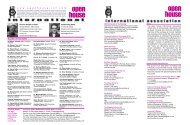Vol :37 Issue No.1 2012 - Open House International
Vol :37 Issue No.1 2012 - Open House International
Vol :37 Issue No.1 2012 - Open House International
You also want an ePaper? Increase the reach of your titles
YUMPU automatically turns print PDFs into web optimized ePapers that Google loves.
Industrialised Building System (IBS) describes the<br />
construction technology in which all building components<br />
such as wall, slab, beam, column and<br />
staircase are mass produced either in factory or at<br />
site factory under strict quality control and minimal<br />
wet site activities (Lim, 2006). Arguably, this system<br />
acts as a catalyst for mass production in construction.<br />
To further boost the industrialisation of the<br />
construction sector, manufacturing concepts are<br />
adopted including the Lean Construction originating<br />
from the car manufacturing industry aiming at<br />
reducing waste from design to delivery (Cuperus,<br />
2003). The <strong>Open</strong> Building concept is also introduced<br />
whereby building occupiers determine specifications<br />
that best suit their needs, thereby creating<br />
the conduciveness for responsibility and care.<br />
The discussion of the literature above has<br />
however, through its emphasis on the production<br />
aspect, addressed mainly the supply side of mass<br />
customisation. An equally, and perhaps even more<br />
critical aspect is the demand side which needs to be<br />
assessed for an indication of the potential market<br />
reception to the concept. While performing the<br />
assessment may not be altogether straightforward,<br />
a considered approach is to study the prospective<br />
buyers in terms of their house-buying preferences<br />
and to examine actual buyers of standard mass<br />
produced housing units in terms of both their satisfaction<br />
on the delivered units and their subsequent<br />
actions on renovation. Examining the respondents’<br />
responses and preferences will provide an understanding<br />
of the demand side behaviour and will<br />
allow certain perspectives to be gained with regard<br />
to the potential of mass customisation in Malaysia.<br />
C OLLECTING THE EVIDENCE<br />
As enumerated earlier, the concept of housing<br />
mass customisation is new to Malaysia. A comprehensive<br />
work on the potential of mass customisation<br />
would require an examination of both the<br />
demand and supply sides. The current study is useful<br />
in that it provides the starting point to the work.<br />
The prime motivation is that no data currently exists<br />
in relation to how ready consumers are for how<br />
housing mass customisation although such data is<br />
important to the housing industry.<br />
A questionnaire survey was adopted. Given<br />
that the main objective is to examine consumer<br />
readiness towards mass customised housing, the<br />
survey was designed with housing consumers as its<br />
target aiming to achieve a reasonable mix of owners<br />
and non-owners of property in the sample. The<br />
rationale for this approach is the consideration that<br />
both the owners and non-owners can provide useful<br />
indications concerning the desirability of mass<br />
customised housing from a prospective buyer’s<br />
point of view, while the owners can additionally<br />
provide indications of the satisfaction from the perspective<br />
of the purchaser who has actually taken<br />
delivery of developer’s standard house. In this manner,<br />
the data can allow the issue to be examined<br />
from two different perspectives with the added benefit<br />
that the comparison could lead to further<br />
insight. For sampling, a systematic procedure had<br />
been adopted while the stock of double-storey<br />
houses was taken as the sampling frame. Because<br />
systematic sampling had been used, the proportions<br />
for owners and non-owners had not been<br />
made to conform to certain a priori values but were<br />
instead allowed to follow the results of the random<br />
process that emanated from the procedure.<br />
Double-storey houses had been adopted as the<br />
sampling frame because this particular housing<br />
sector represents the largest inventory of mass-produced<br />
houses in the country in line with its popularity<br />
among house buyers.<br />
For the purpose of the sampling, the<br />
Peninsular Malaysia was divided into eastern and<br />
western regions. This way of dividing up the peninsula<br />
is not only geographic but also serves the<br />
demographic and economic reasons well. The two<br />
regions are differentiated on their economic<br />
dynamism with the latter showing generally more<br />
progressive and dynamic growths than the latter. In<br />
terms of the demography, the eastern region is<br />
more biased towards the Malay populace while the<br />
western region has a generally more balanced<br />
racial composition.<br />
To achieve the aim of this study, respondent<br />
samples were to be drawn from localities that<br />
would reflect the house buying population in each<br />
region. Based on this consideration, the cities of<br />
Kota Bharu and Kuala Trengganu had been chosen<br />
to represent the eastern region while Shah Alam<br />
and Kemuning the western region. A sample of 120<br />
respondents was targeted for from each locality<br />
1 9<br />
open house international <strong>Vol</strong>.<strong>37</strong> <strong>No.1</strong>, March <strong>2012</strong> Examining The Potential For Mass Customisation... Md. Nasir Daud, Hasniyati Hamzah and Yasmin Mohd Adnan





